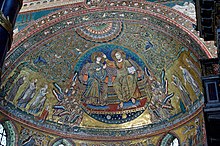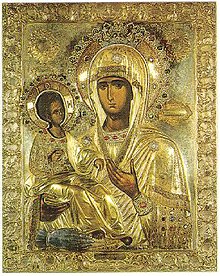Portrait of Mary
In Christian iconography, the portrayal of Mary alone or together with the baby Jesus is called the portrait of Mary , also of the Virgin Mary or Madonna . The popular term Madonna is mainly used for individual depictions of the Mother of God with her child. Since the 3rd century, the image of Mary has been the most common object in Christian art , which is presented on countless visual media and in a variety of contexts and gives the worship of Mary a graphic expression.
Portraits of Mary often take up scenes from the apocryphal Gospel of James , the life of Mary or the life of Jesus Christ . In addition, there are numerous picture cycles and individual representations in which independent picture types have emerged, as well as those that depict certain theological ideas and contexts.
historical development

The story of Marie-portrait is also a history of display types, a history of the events of Marie representation, but also a history of Marian shrines and -wallfahrten and not least a history of Marian devotion, their changing attitudes also brought a change of meaning of the pictorial representations with it. The portrait of Mary also plays an important role in the work of individual artists. These different strands of the history of the image of Mary overlap, the iconography of the Virgin Mary can therefore hardly be systematized because of the countless regional or local peculiarities.
Early Christian art
Early images of Mary date back to the 2nd century. For example, they can be seen in the Priscilla Catacomb in Rome . Mostly, however, Mary was not depicted here independently, but in scenes thematically oriented towards the life of Jesus or the theology of Christ. The number of images of Mary increased after Mary was dogmatized as the Mother of God at the Council of Ephesus in 431 . From this point on, independent types of images of the Virgin Mary developed. The Basilica of Santa Maria Maggiore in Rome is programmatic for the new attitude since the Council of Ephesus .
Byzantine art after the iconoclasm
Byzantine Madonnas and those of the Russian icon use a different and in some cases very uniform form of representation compared to the representation of the Western European images of Mary, even if the Byzantine representations were trend-setting for European images.
Unlike in Western European art, certain types of Madonnas developed in Byzantine art that can be clearly named:
- Hodegetria - figure of Mary who carries the child on her left arm and points to it with her right hand; rarely also as Dexiokratusa with the child on the right arm or Tricherusa ( Church Slavonic : Troeručica ) with three hands
- Nicopoia or Kyriotissa - Mary with child facing the viewer frontally.
- Blacherniotissa, Maria orans - Representation of Mary without a child. Mary raised her arms in prayer.
- Platytera - praying Mary, in front of whom the Christ child is depictedon a clipeus . Both face the viewer frontally.
- Eleusa or Glykophilusa - representation of Mary with the child, with the child nestling against the mother's face
- Psychosostria - soul savior
- Galaktotrophousa , or Maria lactans (medieval) - breastfeeding Maria, who is usually depicted as a half-length figure
- Paraklesis - representation of a Mary without a child; Mary has a scroll as an attribute
Western European art up to the Council of Trent
Western European art developed less strict forms of representation. However, patterns developed here too. Central forms are:
- the enthroned Madonna as Mother of God, with child
- Portraits of Mary standing, with or without a child (in the Romanesque and early Gothic times often in a mandorla , later in a halo )
In the Romanesque period, the Madonna was mostly portrayed solemnly and strictly with the child as Maestà or Sedes sapientiae .
During the Gothic period , numerous types of images were created to depict Mary. However, not every image of Mary can be clearly assigned to a specific type of image. Typical of Gothic Madonnas is the increasing emphasis on their maternal side. Most of the Gothic Madonnas are shown standing and facing the child.
Since the 12th century, scenes from the life of Mary ( Mary's birth , wedding, Holy Family , Mary's death, etc.) have also been preferred . A whole Marie cycle can be found at Lettner of the Cathedral of Chartres . Typical subjects were Anna herself , the English greeting , the Assumption of the Virgin Mary , the Coronation of Mary and the depiction of the Sorrowful Pietà or the Lamentation of Christ .
The Sacra conversazione (Maria in a small circle) is typical of the Renaissance in Italy ; north of the Alps there were the forms of representation of the Virgo inter Virgines (virgin among virgins ) as well as the Maria im Rosenhag or the Maria im Paradiesgarten .
With the revival of the cult of Mary during the Counter-Reformation , Maria is particularly often depicted as the majestic ruler ( Regina Caeli ) or as Immaculata , the Immaculate. If an image of Mary is adorned with a crown, this can be done in the liturgical form of the coronation of an image of Mary . In addition, certain special forms of depicting the Virgin Mary have developed. This includes:
- Marian life
- Crescent Madonna
- Pietà
- Our Lady of the Sign
- Beautiful Madonna
- Protective mantle Madonna
- Black Madonna
- Mater Dolorosa
- Maria Knot Looser
- Maria in the ears of corn
- Motifs from the Lauretan Litany
Latin America
In Latin America, the personification of the goddess Isis , who once came from Egypt as a nurturing mother, who later immigrated to Christianity via polytheism, merged with the cosmic conception of the earth mother to form a figurative pachamama . According to Dieter Grotehusmann, no images can be traced before the 19th century. In the symbol of the Pachamama , pre-Christian ideas and the Christian figure of Mary, Mother of God, are mixed up for the indigenous population .
The painting Our Lady of Guadalupe is an exception among the numerous portraits of Mary . It plays an important role in the Acontecimiento Guadalupano .
See also
Individual evidence
- ↑ Maria, Marienbild. In: Engelbert Kirschbaum u. a. (Ed.): Lexicon of Christian Iconography. Vol. 3, Freiburg 1971, p. 157.
- ↑ a b c Maria, Marienbild. In: Engelbert Kirschbaum u. a. (Ed.): Lexicon of Christian Iconography. Vol. 3, Freiburg 1971, p. 156.
- ↑ Dieter Grotehusmann: Religion and rites of the Aymarà. Field research in the region around Lake Titicaca in Bolivia and Peru (= religions in the plural world, vol. 10). Berlin 2010, p. 260.
literature
- Konrad Algermissen u. a. (Ed.): Lexicon of Marian Studies. Regensburg 1967.
- Wolfgang Beinert , Heinrich Petri (Hrsg.): Handbuch der Marienkunde. Regensburg 1984, ISBN 3-7917-0908-9 .
- Walter Delius : History of the Adoration of Mary. Basel 1963.
- Reiner Dieckhoff: Cologne Madonnas. Emons, Cologne 2009, ISBN 978-3-89705-595-7 .
- Tim Heilbronner: Iconography and contemporary function of wooden seated madonnas in Romanesque Catalonia, Hamburg 2013, ISBN 978-3-8300-6809-9 .
- Stefan Hess : Securing legal continuity or the power of habit. Images of Mary in the post-Reformation Basel. In: David Ganz , Georg Henkel (ed.): Framework Discourses. Cult images in the denominational age. Reimer, Berlin 2004, ISBN 3-496-01312-5 , pp. 331-357.
- Eva-Maria Jung-Inglessis : Roman Madonnas: About the development of the images of Mary in Rome from the beginning to the present. St. Ottilien 1989, ISBN 3-88096-484-X .
- Anna Brownell Jameson: Legends of the Madonna as represented in the fine arts. London 1902.
- Maria, image of Mary. In: Engelbert Kirschbaum u. a. (Ed.): Lexicon of Christian Iconography. Volume 3, Freiburg 1971, ISBN 3-451-14493-X .
- Hermann Lemperle : Madonnen: The Madonna in German sculpture , 1965
- HF Jos. Liell: The representations of the Blessed Virgin Mary, the Mother of God, on the art monuments of the catacombs. Edited dogma and art history. Herder'sche Verlagshandlung, Freiburg im Breisgau 1887.
- Claudia Opitz , Dieter Bauer (Ed.): Maria, image or model? On the social history of medieval devotion to Mary. Tübingen 1990, ISBN 3-89295-539-5 .
- Walter Rothes: The Madonna in her glorification through the fine arts of all centuries. Cologne 1920.
- Heinrich Schmidt, Margarethe Schmidt: The forgotten visual language of art. Beck, Munich 1981, ISBN 3-406-08139-8 .
- A. Schultz: The legend of the life of the Virgin Mary and its representation in the visual arts of the Middle Ages. Leipzig 1878.
- Achille Silvestrini : The life of Mary in the mirror of art. Herrschint 1985, ISBN 3-7796-5233-1 .
- Paul Sträter (ed.): Catholic Marienkunde. Paderborn 1947–1951.
- Kristin Vincke: The Visitation. Iconography of Mary in Italian art until 1600. Cologne 1997, ISBN 3-412-12396-X .
- Jacobus de Voragine : Legenda aurea . Genoa around 1230–1298.
Web links
- All about Mary Extensive, international collection of historical pictures of the Virgin Mary. Retrieved May 17, 2015.

